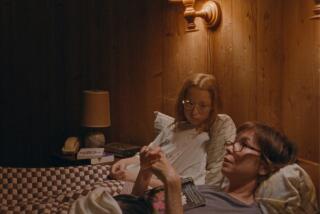You can’t handle the nonfiction, say ‘American Teen’ marketers
WHAT DO “Juno,” “Napoleon Dynamite” and “The Breakfast Club” all have in common? In addition to being about high school kids, they are all being used to sell Paramount Vantage’s new documentary, “American Teen,” one of the summer’s trickiest marketing challenges.
With its bold and sweeping title, “American Teen” certainly promises a lot. Filmmaker Nanette Burstein, co-director of 2002’s critically acclaimed documentary “ The Kid Stays in the Picture,” followed a group of small-town Indiana high schoolers for their entire senior year and crafted a portrait of teenage life that is meant to be both contemporary and yet timeless. With a sharply drawn and surprisingly earnest narrative about the struggles of being a teen, a snappy soundtrack and sections of whiz-bang animation, the film would seem to have an obvious broad, mainstream appeal.
But finding an audience for “American Teen” may be more challenging than you would initially expect, especially during a time when independent films in general -- and documentaries specifically -- have largely been dying at the box office.
Although counter-programming has worked in past summers, almost all specialized film releases have been clobbered by big-budget popcorn movies this season. With its July 25 release date, “American Teen” not only follows “The Dark Knight” and “Mamma Mia” by a week, it also goes head to head with Will Ferrell’s “Step Brothers” and “X-Files: I Want to Believe.”
Paramount Vantage picked up “American Teen” for a reported $1 million at the Sundance Film Festival in January, where the film played to the sort of roof-raising response most filmmakers can only dream of. Since then, Vantage has hardly kept it under wraps, as the film has continued to play at numerous other festivals, including the recent Los Angeles Film Festival. An extensive national series of more than 300 word-of-mouth screenings has also been used to introduce the film to audiences, and the five main teens have been brought to Los Angeles for the summer to promote it.
But just who exactly is “American Teen” intended for? Teens, weaned on rowdy and raucous reality series like “ Laguna Beach” and “The Hills”? Or adults, interested in a nostalgic look back at high school’s painful, as well as uplifting, coming-of-age moments?
“I do think high school kids will relate to this movie and find this movie, but it’s very challenging, if not, dare I say it, impossible, to a sell a movie as an art house release to a high school student,” says Megan Colligan, executive vice president of marketing and publicity for Paramount Vantage. “We’re releasing it as an independent movie. It has a rollout and a relatively small media budget. So we’re directing our attention to our sweet spot of those 18-to-24 recent graduates who go to independent cinema.”
But to get this coveted demographic, the studio has employed what looks like a bit of misdirection. A few months after Sundance, Vantage released a poster with the five teens featured in the film -- who have come through the marketing campaign to be labeled as the Rebel, the Geek, the Princess, the Heartthrob and the Jock -- posed and costumed as a direct reference to the iconic poster from the 1985 teen film “The Breakfast Club.”
While the poster seemed aimed directly at the nostalgia market, or perhaps as a way to get the parents of current teens interested in the film, it raised more than a few eyebrows online, as some were surprised by the use of a decades-old fictional film as a reference point for selling a documentary.
Among those critics was “American Teen’s” director.
“It was fine as an early, teaser poster, but I did not want it to ultimately be the poster of the movie,” Burstein said recently. “I understand it’s hard. How do you market this? You have to explain the film in a very quick way. So I know the challenges of marketing the movie, but that’s the thing, [the kids] are these different, familiar stereotypes, but ultimately the point is they’re so much more complicated than that. It’s hard to get that across very quickly.”
The early poster has since been replaced by a one-sheet that features bold, crayon-bright colors and the kids in contemporary clothes. One version has a quote that mentions by name not only “The Breakfast Club” but also the recent youth-targeted indie hits “Juno” and “Napoleon Dynamite.” The type size for the titles of those films is quite large and makes the type for the word “documentary,” placed almost dead center on the poster as part of a festival laurel from Sundance, by comparison seem microscopic.
“I don’t think it’s that we’re trying to hide the fact that it’s a documentary,” said Colligan. “One of the challenges of this movie is making people feel like this is a cinematic experience that will feel to them like a great teen comedy.”
Since most docs have recently gone largely unseen at the theaters, it’s no surprise that Vantage is not leading with the film’s nonfiction pedigree (for example, another well-reviewed documentary from Sundance, “Bigger, Faster, Stronger*,” has made less than $500,000 at the box office since its release at the end of May). But Burstein hopes that audiences will allow the documentary to speak for itself.
“I feel like the premise of the movie is sometimes hard to put across without it sounding kind of generic,” said Burstein. “But when people see the movie, and I’m not tooting my own horn, the response has been overwhelmingly positive.” Vantage knows “how well people respond to it,” she adds, “so I think they have a lot of hope.”
More to Read
The biggest entertainment stories
Get our big stories about Hollywood, film, television, music, arts, culture and more right in your inbox as soon as they publish.
You may occasionally receive promotional content from the Los Angeles Times.











